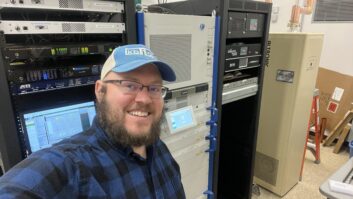The author is chief product officer of GatesAir.

The TV spectrum repack is moving forward. What does it mean for FM broadcasters?
iStockphoto/franckreporter Buzzwords and movements often bubble to the surface in the broadcast industry, only to disappear quickly under water. AM stereo. 3DTV. Many wonder today if 4K television will fully catch on.
One current movement that is a certainty is the TV spectrum repack. The FCC’s recent release of the Reverse Auction Opening Prices serves as clear evidence that the process is moving forward. Between now and May, TV broadcasters across all 210 DMAs (and Puerto Rico) will either commit to going dark and selling their spectrum or remaining on the air. A commitment to the latter option will force the TV station to move to a new UHF or VHF channel assignment.
As with the original analog to digital TV conversion, FM broadcasters on shared tower sites can expect operational disruption on some level. However, taking immediate action and jumpstarting on plans will significantly lessen the impact.
BUILDING A PLAN
Today, approximately 1,200 tower sites accommodate shared TV and FM operations. GatesAir calculates the exact number of FM radio stations and translators on these sites at 2,368, of which 1,300 are full-power stations.
Most of these broadcasters can remain on the same tower. However, outside of the rare case where the TV station can retune existing hardware, there will be substantial changes both inside the plant and up the tower. This is because most RF systems from the transmitter to the antenna are frequency-specific.
This concept may seem foreign to some radio broadcasters. Generally speaking, today’s solid-state FM transmitters, filtering, transmission line and antennas are fully broadband, which makes them easy to retune to any frequency on the traditional FM band. The ability of a UHF station to retune a TV transmitter, antenna and associated RF systems to a new UHF channel is typically not possible, outside of the rare cases where the station is moving to an immediately adjacent channel. Stations moving from UHF and VHF will need completely new systems.
CHANGES IN OUR PLANT
FM broadcasters can begin understanding the potential disruption by evaluating changes inside the plant.
Transmitter buildings generally are compact spaces with limited real estate. A shared site with one TV and one FM broadcaster may house as many as five transmitters, assuming each has a main and a backup transmitter. Perhaps the FM station also has a separate HD Radio transmitter, or the TV station has yet to dispose of its analog transmitter. The latter is more frequent than one might think, given the lack of a secondary analog TV transmitter market as much of the remaining world transitions to DTV.
Complicating the situation is the fact that most repack-driven channel changes will be immediate switchovers. Unlike the original DTV transition, there will be no overlap period where the broadcasters transmit content over two different channels. To prepare accordingly, the broadcaster will typically need to add a new UHF or VHF transmitter to the existing space — most TV broadcasters will opt for a new high-efficiency, energy-saving model even if they can retune their existing transmitters — new line and a new antenna. Therefore, the FM broadcaster could be moved to a new corner of the RF plant that requires changes in cooling, filtering, grounding and electrical access; or worse, if leasing space, be forced to a new, albeit temporary location.
Outside, changes will potentially be even more significant. We estimate that approximately 10 percent of TV broadcasters have a backup antenna on their tower. Most TV broadcasters built their DTV RF systems 10–15 years ago; given the longevity of antennas especially, few have replaced their original hardware.
Therefore, these TV broadcasters will need to find a new home for their new antenna. Since TV transmission generally favors top-mount positioning, the auxiliary antenna for the new channel will require a side-mount location. As most FM antennas are side-mounted — and always when the tower is shared with TV — it’s likely that the FM broadcaster will be forced to move its antenna to a lower position on the tower.
The weight of that extra antenna will put more stress on the existing tower structure, along with the potential requirement for new transmission line. In rare cases, the TV station may be able to at least temporarily share the FM broadcaster’s line if extra capacity exists. This may reduce the stress on the tower structure by allowing crews to remove the old TV transmission line while making way for the new line.
To further complicate things, as tower work commences over a several-year period industry-wide, many towers will need to go dark at certain times of the day to ensure crew safety. Even if the FM broadcaster can remain on the tower at a lower antenna position and at lower power, chances are there will be, at minimum, occasional periods of being off the air. This poses a significant challenge, as over-the-air delivery remains the best way for the radio broadcaster to reach its widest audience.
FM broadcasters can and should begin planning for disruption now, and understand the options that exist to combat service interruptions. Engage TV stations today to understand their planning processes, and identify how work inside and outside the plant will affect each broadcaster’s operation. It is recommended that broadcaster join forces and strategize joint timelines to address design and construction plans. Meanwhile, your transmitter and antenna suppliers, especially those with experience in both TV and radio, will be sure to help you navigate the oncoming — and ongoing — twists and turns.
Comment on this or any article. Email[email protected]with “Letter to the Editor” in the subject field.











